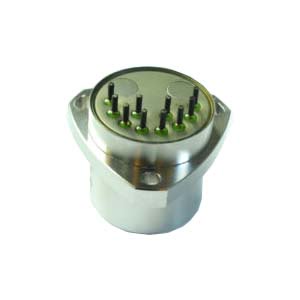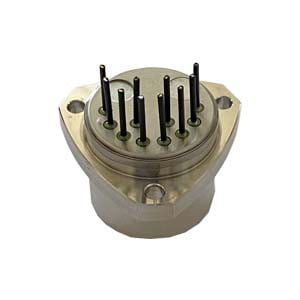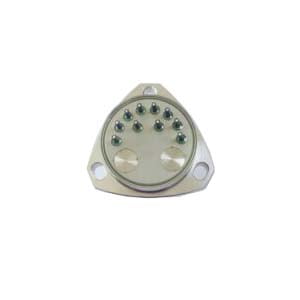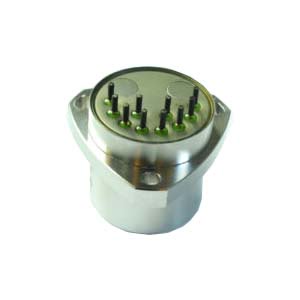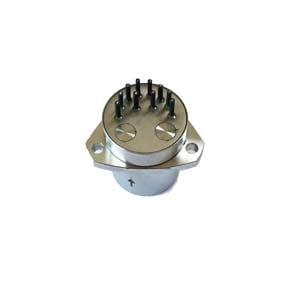The accelerometer is composed of detection mass (also called sensitive mass), support, potentiometer, spring, damper and housing. Constrained by the support of the test mass can only move along one axis, this axis is often called the input axis or sensitive axis. When the instrument housing moves with the carrier along the direction of the sensitive axis, according to Newton's law, the detection mass with a certain inertia tries to keep its original motion state unchanged. A relative movement between it and the housing will cause the spring to deform, so the mass will be accelerated by the force of the spring. When the spring force is balanced with the inertial force generated during the acceleration of the detection mass, there is no longer any relative movement between the detection mass and the housing, and the deformation of the spring reflects the magnitude of the measured acceleration. As a displacement sensing element, a potentiometer converts acceleration signals into electrical signals for output. The accelerometer is essentially a one-degree-of-freedom oscillating system, and dampers must be used to improve the dynamic quality of the system.
There are many types of accelerometers: linear accelerometers are used to classify displacements based on detection mass (linear displacements are used to detect masses) and pendulum accelerometers (detection masses are rotated around support shafts); gem supports and flexible supports are classified according to support methods. , Air float, liquid float, magnetic levitation and electrostatic levitation; according to the composition of the measurement system, there are open-loop and closed-loop types; according to the working principle, there are vibrating-string, vibrating-beam, and pendulum-integrating gyro accelerometers; The number of input shafts is classified into single-axis, dual-axis, and tri-axis accelerometers. According to the sensing element, there are piezoelectric, piezoresistive, and potentiometer types. The characteristics of several different classifications are usually used to name an accelerometer.
Quartz flexible accelerometer is a kind of instrument with high precision, high stability and high reliability based on crystal resonance technology, which uses crystal oscillator as a sensor to measure acceleration and vibration. The technology has the characteristics of no calibration, high resolution, high anti-interference and low noise, and is widely used in industrial control, seismic network, meteorological observation, aerospace, military and other fields.
The components of common accelerometers are as follows: housing (fixed to the measured object), reference mass, sensitive components, signal output, etc. Accelerometers require a certain range and accuracy, sensitivity, etc., and these requirements are often contradictory to some extent. Accelerometers based on different principles have different ranges (from a few g to hundreds of thousands of g), and their sensitivity to abrupt acceleration frequency varies. ER-QA-03A high-performance quartz accelerometer has bias repeatability ≤10μg, scale coefficient repeatability ≤15ppm, Class II nonlinear repeatability ≤ ±10μg /g2 diameter is 25.4X30mm, weight ≤80g, small size, light weight and high reliability, mainly used in the aerospace field of inertial measurement and test systems. It can perform static and dynamic tests and is a standard vibration sensor.
Market prospect
With the continuous improvement of industrial manufacturing technology, the demand for high-precision and high-stability measuring instruments is increasing. At the same time, the demand for accelerometers in the aerospace industry and the military will continue to grow. In addition, the development of new technologies in intelligent manufacturing and the Internet of Things also provides a wider space for the application of quartz flexible accelerometers. The quartz flexible accelerometer market has a broad prospect, and the market size is expected to expand further in the future. At the same time, with the continuous intensification of industry competition, manufacturers' requirements for product quality and technological innovation will continue to increase. Therefore, enterprises should strengthen technology research and development and quality management, enhance product competitiveness, in order to occupy a larger market share.
If you want to get more details about accelerometer,pls visithttps://www.ericcointernational.com/accelerometer/
More Technical Questions
1.Calibration Method of Accelerometer
2.What are the Advantages and Disadvantages of Quartz Accelerometers?
3.How to Improve the Long-term Stability of the Quartz Accelerometer?
4.What Effect Does Temperature Have on Quartz Flexible Accelerometer?
5.Quartz Accelerometer VS MEMS Accelerometer
6.What is Sensitivity and Measurement Range in Quartz Accelerometer?
Products in Article

